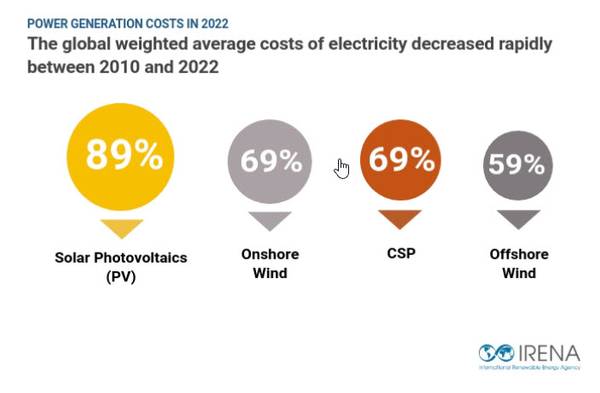
The fossil fuel price crisis has accelerated the competitiveness of renewable power, according to the International Renewable Energy Agency (IRENA). Around 86% (187GW) of all the newly commissioned renewable capacity in 2022 had lower costs than fossil fuel-fired electricity.
IRENA’s report Renewable Power Generation Costs in 2022 indicates that new capacity added since 2000 reduced the electricity sector fuel bill in 2022 by at least $520 billion. In non-OECD countries, just the saving over the lifetime of new capacity additions in 2022 will reduce costs by up to $580 billion.
In addition to these direct cost savings, there would be substantial economic benefits from reducing CO2 emissions and local air pollutants, says IRENA. Without the deployment of renewables over the last two decades, the economic disruption from the fossil fuel price shock in 2022 would have been much worse and possibly beyond many governments ability to soften with public funding.
IRENA’s Director-General Francesco La Camera said: “IRENA sees 2022 as a veritable turning point in the deployment for renewables as its cost-competitiveness has never been greater despite the lingering commodity and equipment cost inflation around the world. The most affected regions by the historic price shock were remarkably resilient, in large part thanks to the massive increase of solar and wind in the last decade.
“Today, the business case for renewables is compelling, but the world must add 1,000GW of renewable power annually on average every year until 2030 to keep 1.5°C within reach, more than three times 2022 levels. There is no time for a new energy system to evolve gradually as was the case for fossil fuels. In preparation of the COP28 in Dubai later this year, today’s report shows once again that with renewables, countries have the best climate solution at hand to raise ambition and take actions in a cost-competitive way.”
Commodity and equipment cost inflation in 2022 resulted in countries experiencing markedly different trends in costs in 2022, IRENA’s new report finds. However, at a global level, the weighted-average cost of electricity fell for utility-scale solar PV by 3%, for onshore wind by 5%, for concentrating solar power (CSP) by 2%, for bioenergy by 13% and for geothermal by 22%.
Only the costs for offshore wind and hydropower increased by 2% and 18% respectively, due to the reduced share of China in offshore wind deployment in 2022 and cost overruns in a number of large hydropower projects.
For the last 13 to 15 years, renewable power generation costs from solar and wind power have been falling. Between 2010 and 2022, solar and wind power became cost-competitive with fossil fuels even without financial support. The global weighted average cost of electricity from solar PV fell by 89% to USD 0.049/kWh, almost one-third less than the cheapest fossil fuel globally. For onshore wind the fall was 69% to USD 0.033/kWh in 2022, slightly less than half that of the cheapest fossil fuel-fired option in 2022.
IRENA’s report concludes that expected high fossil fuel prices will cement the structural shift that has seen renewable power generation become the least-cost source of new generation, even undercutting existing fossil fuel generators. Renewables can protect consumers from fossil fuel price shocks, avoid physical supply shortages and enhance energy security.